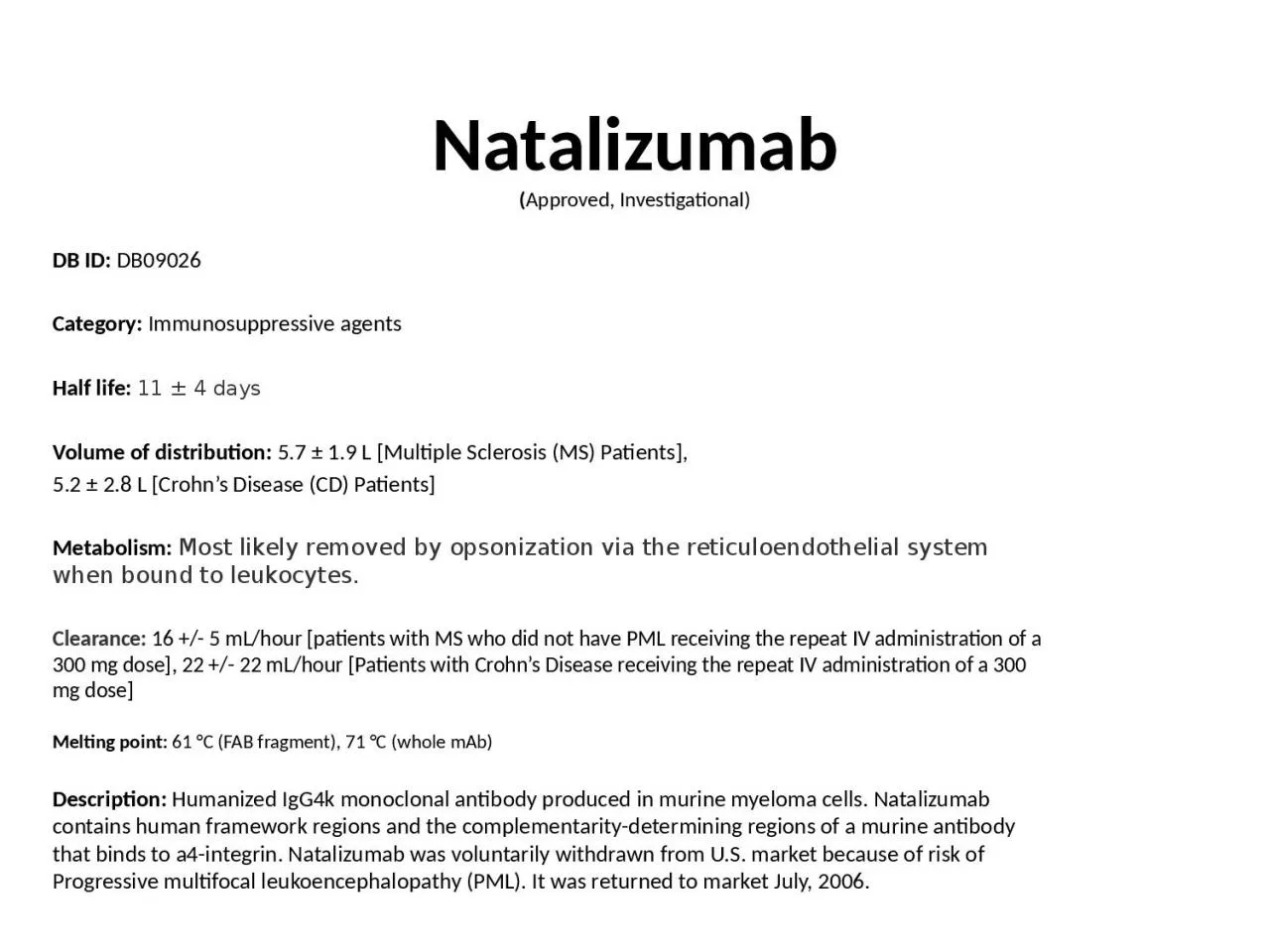

DB ID DB09026 Category Immunosuppressive agents Half life 11 4 days Volume of distribution 57 19 L Multiple Sclerosis MS Patients 52 28 L Crohns ID: 934668
Download Presentation The PPT/PDF document "Natalizumab ( Approved, Investigational)" is the property of its rightful owner. Permission is granted to download and print the materials on this web site for personal, non-commercial use only, and to display it on your personal computer provided you do not modify the materials and that you retain all copyright notices contained in the materials. By downloading content from our website, you accept the terms of this agreement.
Slide1
Natalizumab(Approved, Investigational)
DB ID:
DB09026
Category:
Immunosuppressive agents
Half life:
11 ± 4 days
Volume of distribution:
5.7 ± 1.9 L [Multiple
Sclerosis
(MS)
Patients],
5.2
± 2.8 L [
Crohn’s
Disease
(CD) Patients
]
Metabolism
:
Most likely removed by
opsonization
via the
reticuloendothelial
system when bound to leukocytes.
Clearance:
16 +/- 5
mL
/hour [patients with MS who did not have PML receiving the repeat IV administration of a 300 mg dose
],
22 +/- 22
mL
/hour [Patients with
Crohn’s
Disease receiving the repeat IV administration of a 300 mg dose]
Melting point:
61 °C (FAB fragment), 71 °C (whole
mAb
)
Description:
Humanized IgG4k monoclonal antibody produced in
murine
myeloma cells.
Natalizumab
contains human framework regions and the
complementarity
-determining regions of a
murine
antibody that binds to a4-integrin.
Natalizumab
was voluntarily withdrawn from U.S. market because of risk of Progressive multifocal
leukoencephalopathy
(PML). It was returned to market July, 2006.
Slide2Indication: For treatment of multiple sclerosis.Pharmacodynamics: In multiple sclerosis, lesions are believed to occur when activated inflammatory cells, including T-lymphocytes, cross the blood-brain barrier (BBB). Leukocyte migration across the BBB involves interaction between adhesion molecules on inflammatory cells, and their counter-receptors present on endothelial cells of the vessel wall. The clinical effect of
natalizumab
in multiple sclerosis may be a secondary result of its blockade of the molecular interaction of a 4b 1-integrin expressed by inflammatory cells with VCAM-1 on vascular endothelial cells, and with CS-1 and/or
osteopontin
expressed by
parenchymal
cells in the brain. α4-integrin is required for white blood cells to move into organs, therefore,
natalizumab
prevents these immune cells from crossing blood vessel walls to reach affected organs thereby decreasing
inflamation
.
Mechanism of action:
Binds to the α4-subunit of α4b 1 and α4b 7
integrins
expressed on the surface of all leukocytes except
neutrophils
, and inhibits the α4-mediated adhesion of leukocytes to their counter-receptor(s).
Slide3Brand name: Tysabri Company: Biogen
Idec Inc.
Drug description:
Tysabri
(
natalizumab
) is a recombinant humanized IgG4
κ
monoclonal antibody produced in
murine
myeloma cells.
Natalizumab
contains human framework regions and the
complementarity
-determining regions of a
murine
antibody that binds to
α4-
integrin
. The molecular weight of
natalizumab
is 149
kilodaltons
.
Tysabri
is supplied as a sterile,
colorless
, and clear to slightly opalescent concentrate for intravenous infusion.
Prescribed for:
It is indicated as
monotherapy
for the treatment of patients with relapsing forms of multiple sclerosis.
Tysabri
increases the risk of PML. It is indicated for inducing and maintaining clinical response and remission in adult patients with moderately to severely active
Crohn's
disease with evidence of inflammation who have had an inadequate response to, or are unable to tolerate, conventional CD therapies and inhibitors of TNF-α.
Slide4Formulation: Each 15 mL dose contains 300 mg natalizumab; 123 mg sodium chloride, USP; 17.0 mg sodium phosphate, monobasic, monohydrate, USP; 7.24 mg sodium phosphate, dibasic, heptahydrate
, USP; 3.0 mg
polysorbate
80, USP/NF, in water for injection, USP at pH 6.1.
Route of administration:
Intravenous infusion.
Slide5Dosage: The recommended dose of Tysabri for multiple sclerosis is 300 mg intravenous infusion over one hour every four weeks. The recommended dose of Tysabri
for
Crohn's
disease is 300 mg intravenous infusion over one hour every four weeks.
Tysabri
should not be used with concomitant
immunosuppressants
(e.g., 6-mercaptopurine,
azathioprine
, cyclosporine, or
methotrexate
) or concomitant inhibitors of TNF-α.
Aminosalicylates
may be continued during treatment with
Tysabri
.
Contraindications:
Tysabri
is contraindicated in patients who have or have
hadprogressive
multifocal
leukoencephalopathy
(PML). It should not be administered to a patient who has had a hypersensitivity reaction to
Tysabri
. Observed reactions range from
urticaria
to anaphylaxis
Side effects:
Progressive Multifocal
Leukoencephalopathy
(PML), Hypersensitivity,
Immunosuppression
/Infections